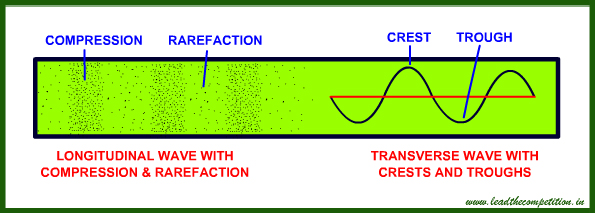Facts about Sound
Basic Facts
- The scientific study of sound waves is known as acoustics.
- Sound comes from vibrations. These vibrations create sound waves which move through mediums such as air and water before reaching our ears.
- Our ears vibrate in a similar way to the original source of the vibration, allowing us to hear many different sounds.
- Sound waves are longitudinal waves with compressions and rarefactions and not transverse waves with crests and troughs. (see diagram below)
- The speed of sound in air is 343 m/s (767 miles per hour or 1,230 kilometres per hour).
- The audible range of sound in human beings is 20 Hz to 20,000 Hz
- Sound waves having frequency below 20 Hz are known as infrasonic waves and those having frequency above 20,000 Hz are known as ultrasonic waves.
- The level of sound prolonged exposure beyond which may cause permanent hearing loss 85 dB
- The loudness of sound is measured in Decibels
- Sounds cannot travel in vacuum
- Sound travels faster in denser media than in rarer due to the increased density and stronger intermolecular forces. Hence, sound travels faster in metals, water etc. than in air.
- The minimum distance which is required to hear an echo 17 metres
- The system of sound reflection used to find the depth of oceans SONAR (Sound navigation ranging)

Interesting Facts
- A woman’s voice is shriller than a man’s voice because of higher Pitch
- The animals which produce sounds of high pitch and frequency to communicate and locate each other Dolphins and elephants
- Stringed instruments have boxes attached to increase the Loudness of the sound produced
- The minimum distance which is required to hear an echo 17 metres
- The system of sound reflection used to find the depth of oceans SONAR (Sound navigation ranging)
- The phenomenon which makes the sound of an approaching train shriller Doppler effect
- Diagnostic ultrasound medical equipment use audio frequency above 20 kHz
Microphone and Speaker
| Microphone | Speaker |
|---|---|
| A microphone is an input device. | A speaker is an output device. |
| A microphone converts sound waves into electrical signals. | A speaker converts electrical signals into sound waves. |
Sonic Boom and Thunder
Both sonic boom and thunder are loud sounds caused by shock waves generated due to different phenomenon.
Thunder is the sound produced by the rapid expansion and contraction of air surrounding a lightning bolt. Lightning bolt heats the surrounding air to extremely high temperatures which causes the air to expand rapidly, creating a shock wave that propagates through the atmosphere and is audible as thunder.
Sonic boom is a loud noise produced when an object, such as an aircraft, travels through the air faster than the speed of sound (supersonic speed). As an aircraft exceeds the speed of sound, it pushes aside the air molecules in its path which creates a shock wave audible to the listener as sonic boom.
Bass and Treble
Bass: Bass refers to the lower-pitched sounds in the audio spectrum. It encompasses the lower frequency range, typically ranging from around 20 Hz to 250 Hz. Instruments like the bass guitar, kick drum, and double bass produce prominent bass frequencies.
Treble: Treble, also known as high frequencies, refers to the higher-pitched sounds in the audio spectrum. It encompasses the higher frequency range, typically ranging from around 2 kHz to 20 kHz. Instruments like cymbals, piccolo, and female vocals produce prominent treble frequencies.
Differences between Sound and Light Waves
| Light Waves | Sound Waves |
|---|---|
| Light waves do not require a medium to travel. | Sound waves require a medium to travel. |
| The speed of light waves is 3 x 108 metres per second | Sound waves travel at a speed of 332 m/sec |
| Light waves are electromagnetic waves. | Sound waves are mechanical waves. |
| Variation in frequency of wave gives different colours. | Variation in frequency of sound waves gives sound with different pitch. |
| Light waves can travel very long distances | Sound waves cannot travel long distances as their energy is dissipated easily. |